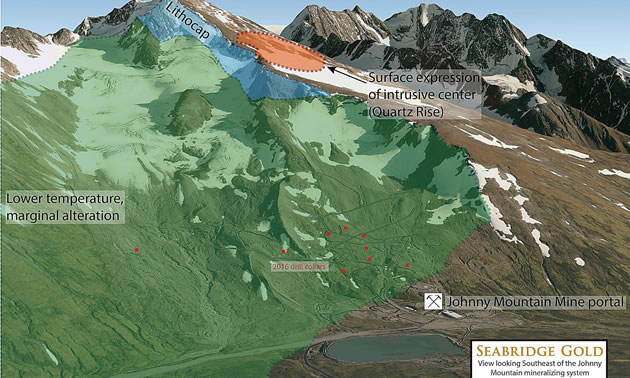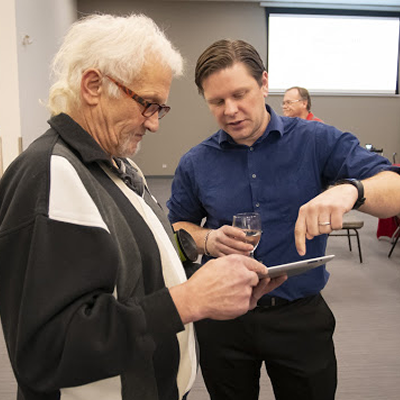Seabridge Drilling confirms promising gold target at Iskut Project

— Photo courtesy Seabridge Gold
TORONTO, Nov. 20, 2017 (GLOBE NEWSWIRE) -- Seabridge Gold (TSX:SEA) (NYSE:SA) announced today that its first exploration program on the Quartz Rise target at its 100%-owned Iskut Project in northwestern British Columbia has been completed and all assay results are in hand. Ten core holes were completed this year totaling 4,459 meters.
This year’s drilling found evidence of a gold-bearing intermediate sulfidation epithermal system beneath the Quartz Rise lithocap as anticipated. Intercepts included 1.5 meters grading 8.26 g/T gold in QR-17-01 and 1.5 meters grading 74.1 g/T gold in QR-17-07. Sampling of a cliff face north of Quartz Rise returned very high grades ranging from 1.49 to 125.3 g/T gold. An economic source for these gold concentrations was not found in the 2017 drilling but the data acquired in this year’s program has defined a target (see below) which could account for these high grade results. A second exploration program is being planned for next year to pursue this target.
This year’s drilling was designed to test a graben feature discovered during surface work on the Quartz Rise lithocap. This graben appears to have constrained the most intense hydrothermal alteration in the area of the lithocap. Drilling focused on the southeastern portion of the graben. Next year’s work will include additional geophysical surveys and drilling along strike of this graben to the northwest. Drill tests will be orientated to optimize intersections with northeast structures and stratigraphic intervals which this year’s program has determined to be the most favorable for higher gold concentrations.
Rudi Fronk, Seabridge Chairman and CEO, commented that “in our first program at Quartz Rise, our exploration team has successfully found the right environment for a high-grade epithermal gold deposit. The system at Quartz Rise has all the earmarks we were looking for and we think we have enhanced the potential for a significant discovery. Further geophysical work completed at the end of this year’s program suggests which part of the system should be targeted next year. Iskut’s similarities with KSM are persuasive and this knowledge should help us zero in on the potential at Quartz Rise.”
Program Description
The program at Quartz Rise began with geological mapping which featured a shallow northeast dipping sequence of Jurassic felsic volcanic rocks deposited unconformably on Triassic marine sedimentary rocks. This is the geological time break that has proved to be productive elsewhere in the region. The entire section of volcanic rocks shows leaching and textural destruction consistent with acidic alteration within an extensive lithocap emanating from an intrusive center. Similar lithocaps host rich epithermal gold systems in some of the world’s best mining districts. A pair of graben-forming faults (labeled #6 and #9) identified in the Jurassic volcanic rocks was mapped in detail, surface sampled and surveyed using short-wave infrared (SWIR) instrumentation to define the areas of most intense alteration. This work led to three specific questions to be answered by drilling:
- Did the graben faults act as conduits for mineralizing fluids?
- Can receptive units be identified within the volcanic stratigraphy?
- Is there a preferred direction within the graben and lithocap with potential to host an intermediate sulfidation epithermal occurrence?
Graben Faults
The graben-forming faults were suspected to be significant precious-metal fluid pathways; they were traceable over several kilometers and they projected into the historical Johnny Mountain Mine where they are recognized as controlling gold distribution within the mine. The best indication that these faults helped to focus gold came from an intersection in QR-17-06; here the #6 fault returned a 3.8 meter interval of 6.52g/ T gold. Elsewhere in hole QR-17-04, a silica breccia zone adjacent to the #9 fault contained anomalous gold concentrations. We have concluded from these results that the graben-forming faults are likely an integral part of the mineralizing system but are not the primary depositional sites for precious metals at Quartz Rise.
Receptive Volcanic Units
The volcanic stratigraphy established from surface mapping and drill holes shows a series of coarse lithic tuff flows intercalated with densely welded flows, incestuous porphyritic sills and tuffaceous sedimentary rocks. In Quartz Rise, the coarse lithic tuff tends to show much more intense leaching and acid alteration then do the densely welded tuff, sills or sedimentary rocks. In several drill intersections, the tuffs directly below the densely welded units or sills contain intervals of anomalous gold, specifically holes QR-17-2 and QR-17-7. These results indicate that the coarse lithic tuff units were permeable to hydrothermal fluids and could represent permissive units for deposition of precious metals.
Vectoring Towards a New Target within the Quartz Rise Graben
Compilation of surface mapping and drill hole geology shows a clear trend of decreased hydrothermal alteration toward the south and east. This is defined by the intensity of acid alteration, better preservation of original volcanic textures and diminishing pathfinder geochemistry. The opportunity for discovery therefore appears to improve to the north and west of the Quartz Rise area, toward historical mining. Furthermore, it has become evident that the northwest trending graben structural pattern does not account for the best gold values found in this year’s program including holes QR-17-01 (1.5 meters grading 8.26 g/T gold) and QR-17-07 (1.5 meters grading 74.1 g/T gold) as well as sampling of a cliff face north of Quartz Rise which returned very high grades ranging from 1.49 to 125.3 g/T gold.
A secondary and subordinate northeast structural orientation has subsequently been defined which is orthogonal to the graben faults and preferentially localizes intervals of high-grade gold. The 2017 Quartz Rise drilling plan was not designed to evaluate this northeast orientation. An IP survey was conducted late in the 2017 program to pursue this idea and its chargeability features provide indirect confirmation of favorable northeast structures which will be targeted in next year’s program.
The results provided in the table above are early-stage and insufficient to establish a true thickness of the mineralized zones. These intervals are provided as an illustration of specific environments encountered in the program and do not represent all the precious metal intervals from the drilling program. Additional drilling will be required to determine the relevance of the widths of drill hole intervals reported here.
Exploration activities by Seabridge at the Iskut Project are being conducted under the supervision of William E. Threlkeld, Registered Professional Geologist, Senior Vice President of the Company and a Qualified Person as defined by National Instrument 43-101. Mr. Threlkeld has reviewed and approved this news release. An ongoing and rigorous quality control/quality assurance protocol is employed in all Seabridge drilling campaigns. This program includes blank and reference standards. Cross-check analyses are conducted at a second external laboratory on at least 10% of the drill samples.
Seabridge holds a 100% interest in several North American gold projects. The Company's principal assets are the KSM and Iskut Projects located near Stewart, British Columbia, Canada and the Courageous Lake gold project located in Canada's Northwest Territories. For a full breakdown of Seabridge's mineral reserves and mineral resources by category please visit the Company's website at http://www.seabridgegold.net/resources.php.




